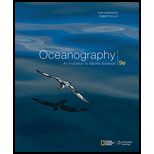
The reason why people think an ocean was deepest at its center. Also, determine the factor that changed their minds.
Answer to Problem 1TC
Since the large ships cannot arrive close to the shore, people reasonably assumed that the gradual slope of the nearshore seabed continued into depths and thereby reached some hypothetical deepest spot near the middle and then, became progressively shallower until the opposite shore is reached. The sporadic deep sampling methods changed their minds.
Explanation of Solution
People were aware of the depth of ocean and when they walk beyond the ocean, and the deeper water comes and they will get wet. When they see boats adjacent to the shore, they recognize that large ships will not be able to come close to the shore. Therefore, they consider that the gradual slope of the nearshore seabed continues into the depths and it reaches some theoretical deepest part adjacent to the center and later becomes progressively shallower until they reach the opposite shore.
Periodic deep sampling methods proved that the indications which the bathtub model showed were not always true. In 1818, during an expedition to observe the Northwest Passage, Sir John Ross collected a series of samples from the bottom. Among that, the deepest one was from about 1,919 meters near Greenland.
The soundings for these samples provided an irregular bottom depth in the North Atlantic and based on his log entries, he discovered that the deepest part of the North Atlantic near is its periphery rather than at its center. Unluckily, Ross was unable to gather enough of the soundings to determine the contour of the seabed.
Over time, the sampling methods became advanced and in 1840s, a sounding method was carried out by a U.S. Navy midshipman, American Commodore Matthew Maury. He used a long lightweight line and lead weight to identify the Mid-Atlantic Ridge. However, the innovation came in the form of echo sounder and it first employed in 1925 aboard the German research vessel Meteor.
Scientists of the Meteor expedition traversed the south Atlantic for two years and studied the depth and contour of the seafloor using the bouncing sound waves from the ocean bottom. As a result, a varied and often extremely rugged bottom profile of seafloor was revealed rather than the flat floor they had expected. The central ridges that are found adjacent to the middle of the Atlantic have counterparts in nearly all the ocean bottoms.
Echo sounders are advanced into today’s multi-beam systems. Unlike a simple echo sounder, a multi-beam system is characterized by as many as 121 beams that are radiating from the hull of a ship. These beams are able to cover the
Normally, a pulse of sound energy is directed toward the seabed every 10 seconds. The sounds that are reflected from the bottom is recorded using listening devices. A continuous swath of coverage beneath the ship can be made from the successive observations. Likewise, a complete map of an area can be made by moving the ship in a coverage pattern.
Want to see more full solutions like this?
Chapter 4 Solutions
Oceanography: An Invitation To Marine Science, Loose-leaf Versin
 Applications and Investigations in Earth Science ...Earth ScienceISBN:9780134746241Author:Edward J. Tarbuck, Frederick K. Lutgens, Dennis G. TasaPublisher:PEARSON
Applications and Investigations in Earth Science ...Earth ScienceISBN:9780134746241Author:Edward J. Tarbuck, Frederick K. Lutgens, Dennis G. TasaPublisher:PEARSON Exercises for Weather & Climate (9th Edition)Earth ScienceISBN:9780134041360Author:Greg CarbonePublisher:PEARSON
Exercises for Weather & Climate (9th Edition)Earth ScienceISBN:9780134041360Author:Greg CarbonePublisher:PEARSON Environmental ScienceEarth ScienceISBN:9781260153125Author:William P Cunningham Prof., Mary Ann Cunningham ProfessorPublisher:McGraw-Hill Education
Environmental ScienceEarth ScienceISBN:9781260153125Author:William P Cunningham Prof., Mary Ann Cunningham ProfessorPublisher:McGraw-Hill Education Earth Science (15th Edition)Earth ScienceISBN:9780134543536Author:Edward J. Tarbuck, Frederick K. Lutgens, Dennis G. TasaPublisher:PEARSON
Earth Science (15th Edition)Earth ScienceISBN:9780134543536Author:Edward J. Tarbuck, Frederick K. Lutgens, Dennis G. TasaPublisher:PEARSON Environmental Science (MindTap Course List)Earth ScienceISBN:9781337569613Author:G. Tyler Miller, Scott SpoolmanPublisher:Cengage Learning
Environmental Science (MindTap Course List)Earth ScienceISBN:9781337569613Author:G. Tyler Miller, Scott SpoolmanPublisher:Cengage Learning Physical GeologyEarth ScienceISBN:9781259916823Author:Plummer, Charles C., CARLSON, Diane H., Hammersley, LisaPublisher:Mcgraw-hill Education,
Physical GeologyEarth ScienceISBN:9781259916823Author:Plummer, Charles C., CARLSON, Diane H., Hammersley, LisaPublisher:Mcgraw-hill Education,





